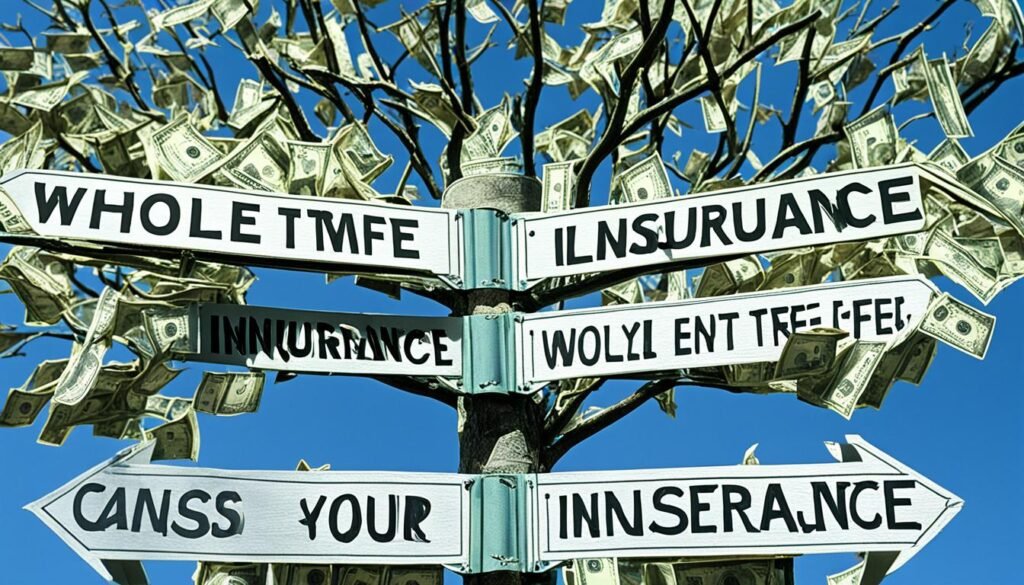Choosing the right life insurance is key to growing your wealth and securing your finances. There are two main types: term life and whole life insurance. Each has its own benefits and differences in costs and how they work.
Term life insurance is a simple choice. It pays out a death benefit for a set time without saving money. For a 35-year-old in good health, a $500,000 policy for 20 years costs about $30 a month, says a June 2023 Policygenius study. It’s great for those who just want protection.
Whole life insurance combines with a cash value account that grows tax-free over time. It also covers you for life. The cost is higher, around $571 a month for a healthy 35-year-old. But it’s a solid choice for those wanting to build wealth and have life insurance.
Whole life premiums are about 20 times term life’s, according to Policygenius. The choice between term and whole life depends on your needs and goals. Knowing about these options helps us find the best life insurance for us.
Let’s explore the details of these life insurance types. We’ll see which one is better for building wealth.
Understanding Life Insurance Policies
Exploring life insurance policies means knowing about permanent and temporary life insurance. We need to understand their costs, benefits, and coverage. This helps us make smart choices for protecting our finances and building wealth.
- Whole Life Insurance: A type of permanent life insurance that covers you for life. It has fixed premiums and a cash account that grows over time. You can borrow against this cash value, ensuring financial stability and growth.
- Term Life Insurance: This is temporary life insurance that covers you for a set time, usually 10 to 30 years. It’s cheaper than whole life insurance because it doesn’t invest. It focuses on providing life insurance coverage only.
When choosing a life insurance policy, consider costs, cash value, and your financial goals. Whole life insurance is good for lasting protection with a cash value. Term life insurance is cheaper and covers you for a set time with stable premiums.
Let’s compare the two:
| Features | Whole Life Insurance | Term Life Insurance |
|---|---|---|
| Coverage Duration | Lifetime | 10-30 Years |
| Premiums | Fixed and Higher | Fixed and Lower |
| Cash Value | Yes, accumulates over time | No |
| Death Benefit | Guaranteed | Guaranteed for the term |
| Affordability | Less Affordable | More Affordable |
Both life insurance types have their own benefits. We should think about our needs and finances to see which one is best for us.
What is Term Life Insurance?
Term life insurance offers simple, temporary coverage at a low cost. It’s perfect for people with short-term financial needs, like paying off a mortgage or raising kids. This type of insurance is easy to understand and doesn’t involve investing like whole life insurance.

Benefits of Term Life Insurance
Term life insurance is known for its low premiums and simple design. The main benefits are:
- Affordable Protection: It costs less than whole life insurance, making it easy on the wallet.
- Flexible Terms: You can choose from terms like 10, 15, 20, and more, fitting your life’s stage.
- Simple Structure: It offers a clear death benefit without the extra cash value.
Drawbacks of Term Life Insurance
Even though it’s affordable, term life insurance has some downsides:
- No Cash Value: It doesn’t grow cash value like whole life insurance does.
- Policy Expiration: If you live past the policy term, it ends without a death benefit.
- Lacks Wealth-Building: It doesn’t help with tax planning or growing wealth, unlike whole life insurance.
Costs and Premiums
Several factors affect the cost of term life insurance:
- Death Benefit Amount: Bigger coverage means higher premiums.
- Term Length: Longer terms mean higher premiums too.
- Health Status: Your age, health, and gender play a big part in the cost.
For example, monthly premiums for a 35 to 45-year-old wanting $250,000 coverage without smoking history range from $17 to $39. This shows how term insurance is cheaper than whole life, making it great for short-term needs.
What is Whole Life Insurance?
Whole life insurance is a kind of permanent life insurance. It gives policyholders coverage for their entire lives and a savings part called cash value. This type of insurance helps ensure that the policyholder’s loved ones get a guaranteed death benefit. It also lets the policy be used as a financial tool during the policyholder’s life.
Benefits of Whole Life Insurance
Whole life insurance has many benefits. Policyholders can borrow against or take money from the cash value, which grows over time. This cash can be used for different financial needs, giving policyholders flexibility. Plus, the cost of premiums stays the same for the policyholder’s whole life, making budgeting easier. Whole life insurance might also grow in value through dividends, making it even more valuable.
- Lifelong coverage with a guaranteed death benefit.
- Cash value accumulation that grows over time.
- Fixed premium payments ensuring budget stability.
- Potential dividend payments increasing policy value.
- Ability to borrow against or withdraw from the policy.
Drawbacks of Whole Life Insurance
Whole life insurance has its downsides. One big issue is it costs a lot more than term life insurance. A 40-year-old woman who doesn’t smoke might pay about $1,000 a month for whole life insurance. This is way more than the $52 a month she’d pay for a 20-year, $1 million term life insurance policy.
Whole life insurance policies are also complex and might have surrender charges if you cancel early. These factors can make whole life insurance less appealing to some people.
- Higher premium payments compared to term life insurance.
- Complexity in policy terms and conditions.
- Potential surrender charges if terminating the policy early.
Cost Comparison
Looking at the costs of term and whole life insurance shows that whole life is much pricier. But, these higher costs pay for the guaranteed death benefit and help grow the policy’s cash value. For example, a 40-year-old woman who doesn’t smoke might pay a lot more for whole life insurance than for term life insurance.
| Insurance Type | Monthly Cost | Coverage Amount |
|---|---|---|
| Term Life Insurance | $52 (20-year term) | $1 million |
| Whole Life Insurance | $1,000 or more | $1 million |
The choice between term and whole life insurance depends on your financial goals and what you want for the long term. Whole life insurance is good for those who want stability and a financial resource for life, even if it costs more.
Whole Life vs. Term Life: Key Differences
Choosing between whole life and term life insurance is important. Both types of policies cover you, but they differ in coverage length, cost, and cash value growth potential.

Term life insurance provides coverage for a set time, like 10, 20, or 30 years. It’s known for being affordable, with an average cost of $26 a month in 2023, says Policygenius. This type of policy doesn’t grow cash value. It’s best for those needing temporary protection, like for young families or mortgages. But, if you outlive the policy, there’s no death benefit.
Whole life insurance covers you for your entire life if you keep paying premiums. It costs more than term life because it also builds cash value. You can use this cash value for loans or withdrawals. Plus, the cost of whole life insurance stays the same over time, unlike term life which can increase when renewed.
| Key Aspects | Term Life Insurance | Whole Life Insurance |
|---|---|---|
| Coverage Period | 10, 20, or 30 years | Lifetime protection |
| Average Monthly Premium | $26 (in 2023) | Higher, due to the cash value component |
| Cash Value | None | Accumulated, can be accessed through withdrawals/loans |
| Premiums | Lower, no investment component | Higher, fixed premiums |
Term life insurance is often seen as a budget-friendly and straightforward choice. Yet, whole life insurance gives you coverage for life and lets your cash value grow. The choice between these policies depends on your financial goals and needs. Both have unique benefits, whether you want short-term security or a long-term plan for your estate and wealth.
Cash Value Accumulation and Wealth Building
It’s important to know the differences between whole and term life insurance if you want to build wealth. Both types have their own roles in planning your finances, but they handle cash value and investments differently.
How Whole Life Insurance Builds Cash Value
Whole life insurance offers coverage for your entire life and also builds cash value. These policies cost more than term life because of this cash value feature. A part of what you pay goes into a cash value account, which grows over time and is invested without taxes.
You can use this cash value for loans, withdrawals, or to pay future premiums. This makes it a strong way to build wealth.
For instance, a $100,000 whole life policy could grow its cash value from $3,738 at age 40 to $289,301 at age 90. If you paid all premiums yourself. This steady growth is a key part of your financial plan.
| Component | Allocation |
|---|---|
| Death Benefit | Part of the premium |
| Insurer’s Costs/Profits | Part of the premium |
| Cash Value | Part of the premium |
Term Life Insurance and Wealth Accumulation
Term life insurance doesn’t build cash value but has lower premiums. In 2023, the average monthly premium was $26. This can save you money, which you can then invest elsewhere, like in stocks or retirement funds.
Term life insurance is great for temporary coverage and saving money. You can use these savings to improve your financial plan. Even though it doesn’t add to your wealth through cash value, smart investing of these savings can help your overall financial strategy.
Policy Duration and Coverage Period
Understanding the policy duration and coverage period is key in life insurance. It affects both temporary and lifetime coverage. Term life insurance, or temporary life insurance, has an end date. It can last from 10 to 40 years, covering only the chosen term. After the term ends, the insurance stops, making it great for paying off a mortgage or funding education.
Whole life insurance, however, offers lifetime coverage. It doesn’t expire as long as you keep paying premiums. This means you’re covered for life, making it a solid choice for planning your legacy. It ensures your loved ones get a payout, no matter when you pass away, giving them lasting financial security.
Let’s compare term and whole life insurance premiums:
| Policy Type | Coverage Amount | Annual Premium (Men, Nonsmokers) | Annual Premium (Women, Nonsmokers) |
|---|---|---|---|
| Term Life Insurance (20 years) | $500,000 | $2,352 | $1,656 |
| Whole Life Insurance | $500,000 | $3,593 | $3,173 |
Term life insurance is cheaper, perfect for short-term needs. But whole life insurance gives you coverage for life. When picking between them, think about your financial goals and family needs.
Which Life Insurance Policy is Right for You?
Choosing the right life insurance policy is key to reaching your financial goals and protecting your loved ones. It’s important to compare policies carefully to match your needs and situation.
- Term life insurance is great for those who need affordable, straightforward coverage for a certain time. It’s perfect for covering temporary financial needs like mortgages or college tuition.
- Term policies last 10, 20, or 30 years, and the cost stays the same during that time.
- For a 20-year term policy with a $500,000 death benefit, a healthy 30-year-old pays about $26 a month.
- A study by Penn State University found that 99% of term policies don’t pay out.
- Even though premiums are lower, the death benefit is only active during the policy term.
Whole Life Insurance:
- Whole life insurance is for those who can afford higher premiums and value the investment part. It offers long-term coverage and cash value growth.
- It has level premiums for the policyholder’s lifetime and a guaranteed death benefit.
- A $500,000 whole life policy costs about $451 a month for a healthy 30-year-old.
- The cash value grows over time, based on an interest rate, and can be borrowed against.
- Whole life insurance covers you for life, giving peace of mind to you and your loved ones.
When picking a life insurance policy, think about your age, health, financial stability, and long-term goals. A detailed comparison will help you find a policy that meets your personal and family financial needs.
| Feature | Term Life Insurance | Whole Life Insurance |
|---|---|---|
| Duration | Fixed (10, 20, 30 years) | Lifetime |
| Cost (Monthly Average) | $26 | $451 |
| Premiums | Level during term | Level for life |
| Cash Value | None | Yes |
| Death Benefit | Guaranteed during term | Guaranteed for life |
Conclusion
Choosing the right life insurance is key to a strong protection strategy. With many American families facing financial trouble within six months after losing a main income, picking the right life insurance is crucial. You can go for term life insurance for up to 30 years or whole life insurance for lifelong coverage with cash value.
Term life insurance is great for short-term needs, like when you’re raising kids or paying off debts. On the other hand, whole life insurance is pricier but offers benefits like a guaranteed death benefit and cash value growth. It’s good for long-term planning and building wealth.
Indexed universal and variable universal life insurance also offer savings linked to market trends or investments. The choice of life insurance depends on your personal situation and goals. When making this choice, think about how long you need coverage, the cost of premiums, and the chance to grow cash value. This way, you get a solid safety net that matches your financial goals and protects your loved ones.



